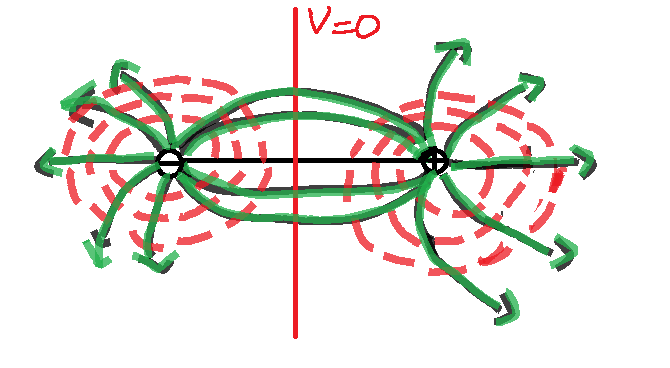
The equipotential surface of a dipole is:
A. A sphere whose centre coincides with the centre of electric dipole.
B. A plane surface inclined at an angle of with the axis of the electric dipole.
C. A plane surface passing through the centre of the electric dipole and perpendicular to the axis of the electric dipole.
D. Any plane surface parallel to the axis of electric dipole.
Answer
591.9k+ views
Hint: Equipotential surface is a surface in which the potential is constant throughout.
Complete step by step answer:

The above figure shows how an equipotential surface of a dipole looks like. The green lines signifies the electric field and the red lines signifies the equipotential surface around the dipole.
The two charges in a dipole form its own electric field and the field density will be more along the axis of dipole, since the dipole consists of opposite charges. So the equipotential surface will be present at the centre of the dipole, which is a line perpendicular to the axis of the dipole and potential value is zero along the line.
So the answer to the question is option (C)- A plane surface passing through the centre of the electric dipole and perpendicular to the axis of the electric dipole.
Note: Equipotential surfaces are like contour lines on a map which traces lines of equal altitude. Altitude refers to electric potential or voltage. Equipotential lines are always perpendicular to the electric field, so that the work done in moving a charge along these lines is zero. In three dimensions the lines from equipotential surfaces.
Complete step by step answer:

The above figure shows how an equipotential surface of a dipole looks like. The green lines signifies the electric field and the red lines signifies the equipotential surface around the dipole.
The two charges in a dipole form its own electric field and the field density will be more along the axis of dipole, since the dipole consists of opposite charges. So the equipotential surface will be present at the centre of the dipole, which is a line perpendicular to the axis of the dipole and potential value is zero along the line.
So the answer to the question is option (C)- A plane surface passing through the centre of the electric dipole and perpendicular to the axis of the electric dipole.
Note: Equipotential surfaces are like contour lines on a map which traces lines of equal altitude. Altitude refers to electric potential or voltage. Equipotential lines are always perpendicular to the electric field, so that the work done in moving a charge along these lines is zero. In three dimensions the lines from equipotential surfaces.
Recently Updated Pages
Master Class 12 Business Studies: Engaging Questions & Answers for Success

Master Class 12 Economics: Engaging Questions & Answers for Success

Master Class 12 English: Engaging Questions & Answers for Success

Master Class 12 Maths: Engaging Questions & Answers for Success

Master Class 12 Social Science: Engaging Questions & Answers for Success

Master Class 12 Chemistry: Engaging Questions & Answers for Success

Trending doubts
What are the major means of transport Explain each class 12 social science CBSE

Which are the Top 10 Largest Countries of the World?

Draw a labelled sketch of the human eye class 12 physics CBSE

Explain sex determination in humans with line diag class 12 biology CBSE

The pH of the pancreatic juice is A 64 B 86 C 120 D class 12 biology CBSE

Explain sex determination in humans with the help of class 12 biology CBSE




